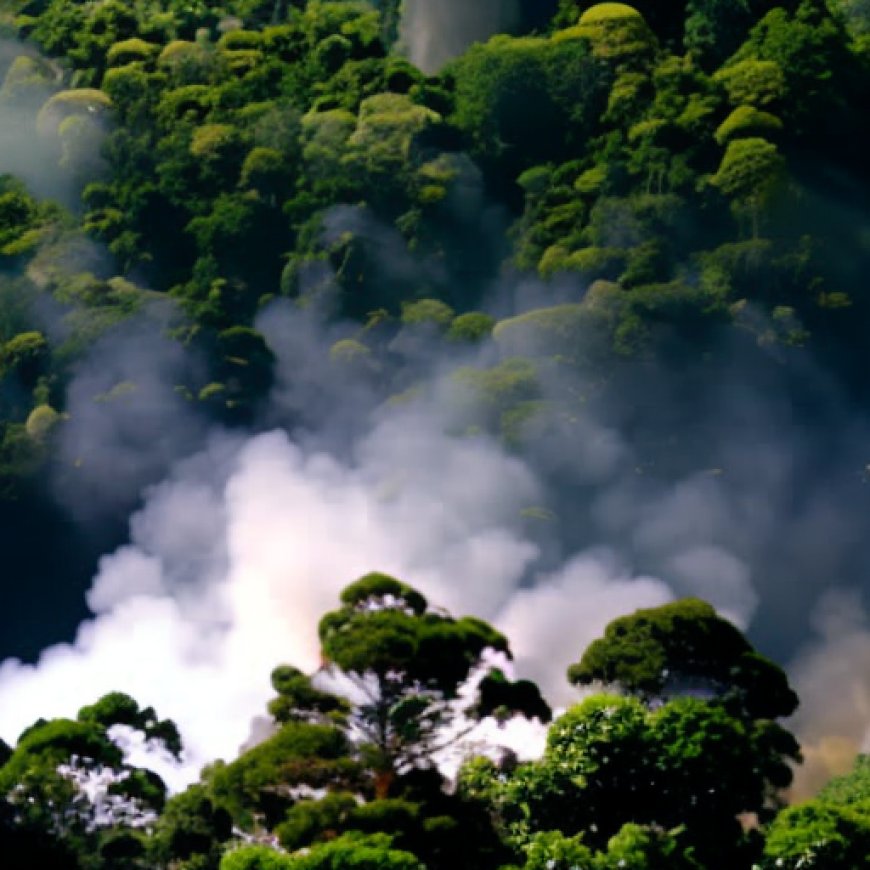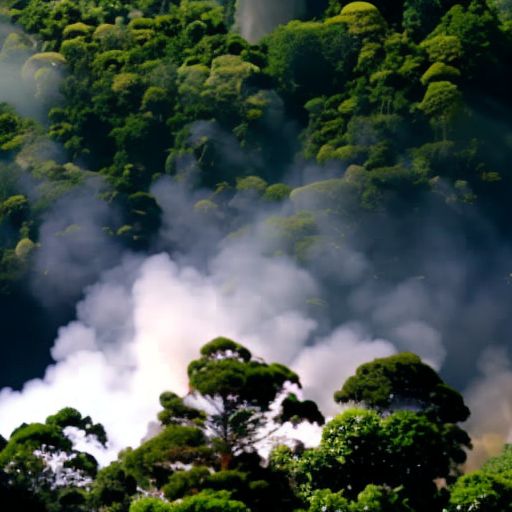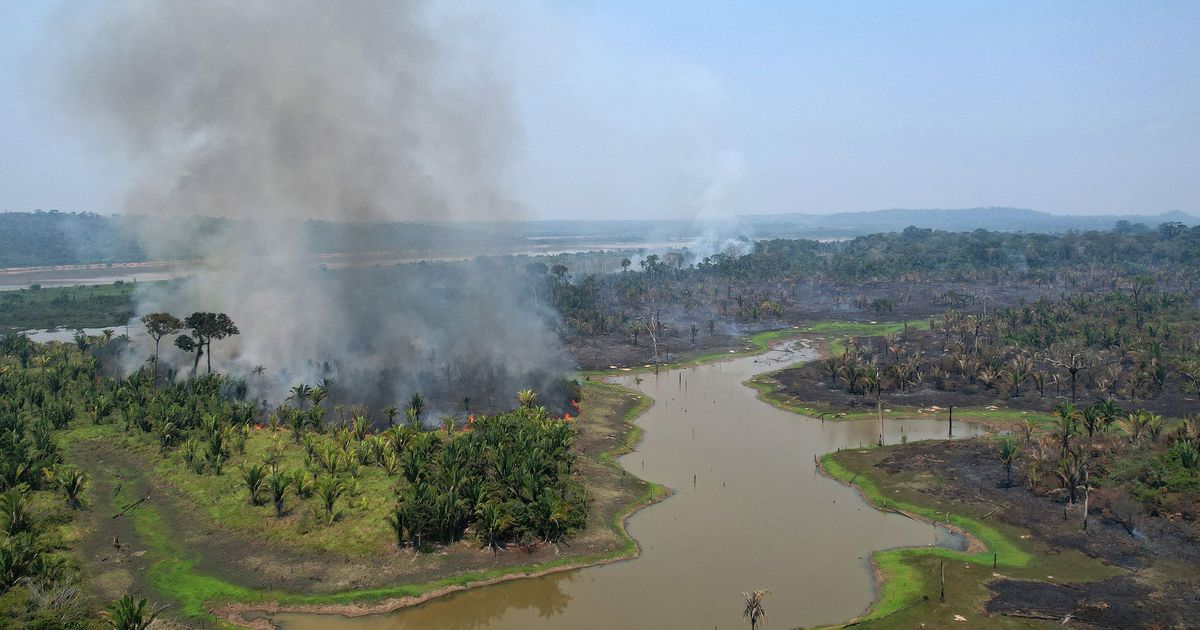Megafires are raging in drought-stricken Amazon rainforest
Megafires are raging in drought-stricken Amazon rainforest The Spokesman Review


Rainforest Fires in the Amazon Raise Concerns for Sustainable Development Goals

By this time of the year, rain should be drenching large swaths of the Amazon rainforest. Instead, a punishing drought has kept the rains at bay, creating dry conditions for fires that have engulfed hundreds of square miles of the rainforest that do not usually burn.
Crisis in the Amazon Rainforest
The fires have turned the end of the dry season in the northern part of the giant rainforest into a crisis. Firefighters have struggled to contain enormous blazes that have sent choking smoke into cities across South America.
A record number of fires so far this year in the Amazon has also raised questions about what may be in store for the world’s biggest tropical rainforest when the dry season starts in June in the far larger southern part of the jungle.
Impact on Sustainable Development Goals
Last month, Venezuela, northern Brazil, Guyana, and Suriname, which encompass vast stretches of the northern Amazon, recorded the highest number of fires for any February, according to Brazil’s National Institute of Space Research, which has been tracking fires in the rainforest for 25 years. Fires also burned across Colombia’s Andes highlands, as well as parts of that country’s Amazon territory.
The fires in the Amazon, which reaches across nine South American nations, are the result of an extreme drought fueled by climate change, experts said.
The region has been feeling the effects of a natural weather phenomenon known as El Nino, which can worsen dry conditions that were intensified this year by extremely high temperatures.
That has made the rainforest more vulnerable to fast-spreading blazes, said Ane Alencar, the science director at the Amazon Environmental Research Institute in Brazil.
“The climate is leaving forests in South America more flammable,” she said. “It’s creating opportunities for wildfires.”
As countries continue to burn fossil fuels and the planet reaches the highest average temperatures measured by scientists, a grueling year of fires is expected around the world. Severe blazes have already ravaged large parts of the United States and Australia, and a worse season is forecast for Canada, where more acres burned last year than had ever been recorded.
Another year of devastating fires could be especially damaging in the Amazon, which stores vast quantities of carbon dioxide in its trees and soil. It is also home to 10% of the planet’s plants, animals, and other living organisms.
If deforestation, fires, and climate change continue to worsen, large stretches of the forest could transform into grasslands or weakened ecosystems in the coming decades.
That, scientists say, would trigger a collapse that could send up to 20 years’ worth of global carbon emissions into the atmosphere, an enormous blow to the struggle to contain climate change.
Current Situation and Future Outlook
In January, wildfires burned almost 4,000 square miles of the Brazilian Amazon, an almost fourfold increase from the same month last year, according to Mapbiomas, a collective of climate-focused nonprofit organizations and research institutions.
In February, more than two-thirds of the fires in Brazil have occurred in Roraima, the country’s northernmost state. They have burned homes and subsistence crops in several Indigenous villages, leaving a thick haze over rural areas and creating hazardous air quality in the state’s capital, Boa Vista.
Researchers say that most of the fires sweeping through the region were initially set by farmers using the “slash and burn” method to allow new grass to grow on degraded pastures or to fully clear recently deforested land.
Fueled by the dry conditions and searing temperatures, many of these fires burn out of control, spreading miles beyond the area that was originally set ablaze.
Environmental factors are already changing the Amazon. Dry seasons are becoming longer, and average rainfall during those periods, when rains diminish but do not stop altogether, has already dropped by one-third since the 1970s, Berenguer said. That has made El Ninos increasingly dangerous.
The fires in the Amazon region have had a striking effect on carbon emissions. In February, wildfires in Brazil and Venezuela emitted almost 10 million tons of carbon, the most ever recorded for the month and about as much as Switzerland emits in a year, according to data from Europe’s Copernicus Atmosphere Monitoring Service.
The El Nino pattern should wind down in a few months, bringing some respite to the Amazon.
But more devastating fires could erupt if the parched soil does not receive enough rainfall in the crucial wetter months ahead, Alencar said.
“The question is whether the forest can recover before the dry season, whether the Amazon can recharge its batteries,” Alencar said. “Now it all depends on the rains.”
This article originally appeared in The New York Times.
SDGs, Targets, and Indicators
| SDGs | Targets | Indicators |
|---|---|---|
| SDG 13: Climate Action | Target 13.1: Strengthen resilience and adaptive capacity to climate-related hazards and natural disasters | – Number of fires in the Amazon rainforest – Extent of wildfires in the Amazon rainforest – Carbon emissions from wildfires in the Amazon rainforest |
| SDG 15: Life on Land | Target 15.1: Ensure the conservation, restoration, and sustainable use of terrestrial and inland freshwater ecosystems and their services | – Extent of deforestation in the Amazon rainforest – Number of protected areas affected by fires in the Amazon rainforest – Impact on biodiversity in the Amazon rainforest |
| SDG 7: Affordable and Clean Energy | Target 7.2: Increase substantially the share of renewable energy in the global energy mix | – Proportion of energy derived from renewable sources in the Amazon region |
1. Which SDGs are addressed or connected to the issues highlighted in the article?
SDG 13: Climate Action
The article discusses the impact of climate change on the Amazon rainforest, particularly in relation to the increase in fires due to extreme drought conditions. SDG 13 aims to take urgent action to combat climate change and its impacts.
SDG 15: Life on Land
The article highlights the potential damage to the Amazon rainforest, which is a vital terrestrial ecosystem. SDG 15 focuses on protecting, restoring, and promoting the sustainable use of terrestrial ecosystems, including forests.
SDG 7: Affordable and Clean Energy
The article mentions the use of the “slash and burn” method by farmers, which contributes to the spread of fires in the Amazon. SDG 7 aims to ensure access to affordable, reliable, sustainable, and modern energy for all.
2. What specific targets under those SDGs can be identified based on the article’s content?
Target 13.1: Strengthen resilience and adaptive capacity to climate-related hazards and natural disasters
The article emphasizes the need to address the increasing frequency and intensity of fires in the Amazon rainforest, which are exacerbated by climate change. Target 13.1 focuses on building resilience and adaptive capacity to climate-related hazards and natural disasters.
Target 15.1: Ensure the conservation, restoration, and sustainable use of terrestrial and inland freshwater ecosystems and their services
The article highlights the importance of conserving and restoring the Amazon rainforest, which is a unique and biodiverse ecosystem. Target 15.1 aims to ensure the conservation, restoration, and sustainable use of terrestrial ecosystems and their services.
3. Are there any indicators mentioned or implied in the article that can be used to measure progress towards the identified targets?
Yes, there are indicators mentioned or implied in the article that can be used to measure progress towards the identified targets:
- Number of fires in the Amazon rainforest: This indicator can measure the frequency and extent of fires in the region, reflecting the resilience and adaptive capacity to climate-related hazards (Target 13.1).
- Extent of wildfires in the Amazon rainforest: This indicator can assess the impact of fires on the ecosystem and the effectiveness of conservation efforts (Target 15.1).
- Carbon emissions from wildfires in the Amazon rainforest: This indicator can measure the contribution of fires to greenhouse gas emissions and climate change (Target 13.1).
- Extent of deforestation in the Amazon rainforest: This indicator can track the loss of forest cover and the impact on terrestrial ecosystems (Target 15.1).
- Number of protected areas affected by fires in the Amazon rainforest: This indicator can assess the effectiveness of conservation measures and the vulnerability of protected areas (Target 15.1).
- Impact on biodiversity in the Amazon rainforest: This indicator can measure the loss of plant and animal species due to fires and deforestation (Target 15.1).
- Proportion of energy derived from renewable sources in the Amazon region: This indicator can assess progress towards sustainable energy use and reducing reliance on fossil fuels (Target 7.2).
4. SDGs, Targets, and Indicators
| SDGs | Targets | Indicators |
|---|---|---|
| SDG 13: Climate Action | Target 13.1: Strengthen resilience and adaptive capacity to climate-related hazards and natural disasters | – Number of fires in the Amazon rainforest – Extent of wildfires in the Amazon rainforest – Carbon emissions from wildfires in the Amazon rainforest |
| SDG 15: Life on Land | Target 15.1: Ensure the conservation, restoration, and sustainable use of terrestrial and inland freshwater ecosystems and their services | – Extent of deforestation in the Amazon rainforest – Number of protected areas affected by fires in the Amazon rainforest – Impact on biodiversity in the Amazon rainforest |
| SDG 7: Affordable and Clean Energy | Target 7.2: Increase substantially the share of renewable energy in the global energy mix | – Proportion of energy derived from renewable sources in the Amazon region |
Behold! This splendid article springs forth from the wellspring of knowledge, shaped by a wondrous proprietary AI technology that delved into a vast ocean of data, illuminating the path towards the Sustainable Development Goals. Remember that all rights are reserved by SDG Investors LLC, empowering us to champion progress together.
Source: spokesman.com

Join us, as fellow seekers of change, on a transformative journey at https://sdgtalks.ai/welcome, where you can become a member and actively contribute to shaping a brighter future.







